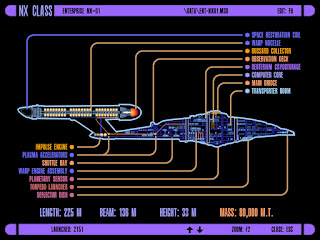The following is a list of links to online resources for Star Trek Adventures games. Before we get into the meat of it, a lot of this is just curated links to specific blog entries by various people on the internet. This means 2 things.
Firstly, it means that there's a lot more content than just what I linked to. All of these bloggers are great, and you should read their actual blogs too.
Secondly, it means this page has a lifespan. Blogs deteriorate and die over time. Eventually nothing on this page will work. Use what you can while you can, nothing lasts forever. Show your appreciation to the people who made these resources; continued attention and praise is what keeps these things alive.
1. The Trove
The Trove is the most enduring online RPG preservation site in existence. How they survive in this age of aggressive copyright territorialism is beyond me. But they do. If you want to learn a game before you spend 60-80$ on the real book, this is where you go. If you already bought the real book and don't want to pay twice just to have a PDF copy, this is where you go. If the company refuses to make a PDF of their game, this is where you go. For STA, The Trove actually has two folders. My guess is that there are too many cooks in the kitchen, but they mean well at least. Here are the links directly to STA material.
Folder 1
Folder 2
Modiphius is unusually fan-focused compared to game design companies of the past. They have provided an online app that allows you to create characters using content from all currently published content. You can then save your high quality character sheet in PDF format and print it from home. This tool essentially means the players don't need to have their own copy of the book just to play!
This tool does not work on mobile, but I promise you, it is worth shackling yourself to the desktop if you plan to run this game. Basically, it's a digital custom paper doll tool. After you design your paper doll, you can use prtscrn to take a picture of your work, then cut the image up in ms paint to make a paper stand fold-up, then copy that image into word to format it for printing. It's a little bit of work, but you'll likely only need to do it a few times, and the results are spectacular.
Another web app. This one works on mobile, but the formatting gets a little buggy on big systems. Basically, it generates all the details of a star system, right down to resources and life forms available on the various planets. It even gives you a detailed visual representation of the star system it generated! Very neat!
Ignore the janky work tracker at the top of the page. Beneath that is a real gemstone: a form-fillable LCARS PDF! Ever wanted to hand out a professional looking mission briefing from Star Fleet Command? Now you can! You can also print the blank white version on the back of your players' character sheets to give them a notes section! Comes in ultra-expensive black and printer friendly white variants.
There's a fair number of these on the internet, but this one is a web app, no page reloading. It allows you to calculate speed from warp factor, or distance travelled by warp over time! In real time! It even let's you select whether you're using the TOS or TNG scale! Now, I know STA kind of expects the GM to have the ship move at the speed of plot, but I like to genuinely give my players autonomy over their movements. After all, what's the point of making an expert helmsman if the GM is really in the driver's seat? So I use this to figure out my players' time through the star system. Oh, for anyone who's wondering, each sector on the STA star chart is 20 lightyears across. It works out that roughly every 3mm is 1 lightyear, if youre using the inside-cover maps. You're welcome.


7. The Wikis
Memory Alpha is the ultimate source for cannon Star Trek information regarding the mainline franchise. You can use it to plan your campaigns and you can let your players use it as their ship's computer!
Memory Beta is the ultimate source for expanded (non-canon) Star Trek information from all of the side products, like TAS, the books, the other RPGs, etc. If you want to add more fluff to your setting, you can use this to supplement Memory Alpha
A handy PDF that clarifies how a starship attack works. If anything, it really just illustrates how elaborate starship combat can really be.
Milestones are actually fairly uncommon. If you play biweekly, the party only gets 1 milestone every other month if you play by the game's recommendations! This means your players WILL forget how many milestones they've had. This sheet, if printed to the back of their character sheet, allows them to keep track of their character's development progress!
This is a learning resource for new GMs and players who are struggling with the task resolution system. A handy teaching tool, especially of you aren't playing with adults or older teenagers.
11. Figure Matrices
These sheets allow you to make hexagonal tokens that carry all the core stats of a character or ship on their face. Just buy some 10lb paper and print them out to make use of the things in your game! Personally, as a cheapo with no figures, I just use these as map tokens.
For Characters
For Starships
Apparently a lot of people struggle with the concept of extended tasks when they first start playing. Here is a handy guide to what to do.
This is a series of PDFs of printable forms that you can use to keep track of all the convoluted ways information is handled on a starship in STA. I think these are an interesting way to perhaps help the players feel like actual Starfleet officers doing work on a PADD. Maybe decorate a clip board for each player to hold all their forms and character sheet info!
This is a reference sheet (of exceptional production quality) that you can use to guide yourself and your players through quickly making up a cast of
mooks! I mean
redshirts! I mean
meatshields! I mean
backups! Oh you know what I mean.
Keep forgetting the traits in the scene? Having trouble remembering the traits you planned for a scene? Players having trouble keeping track of it all inside their heads? Never fear, now you can make a character sheet for the scene! Just print out this luxurious form and write the traits out, then set it in the middle of the table for all to see!
16. SFX
Here is a couple of star trek soundboards. Pull up your phone during the game and tap away as things happen in the game! Takes a little practice to remember which sounds you want to use for which systems/events.
The ugly but extensive one.
The pretty but limited one.
17. Ship and Era Specific Starship Sheets
Ever get annoyed with how your TOS era Miranda class ship is using a TNG style character sheet with the outline of a galaxy class ship? Go here. Click around a bit. You'll find a sheet for just about every published Federation ship for each era it is appropriate for. All in PDF format so they print clean and pretty. There's also a form fillable TOS character sheet hidden in there as a fun little Easter egg.
http://enklave-23.de/STA_Sheets/
Now, the style is so similar I'm not sure, but these additional ship specific sheets by Cory Belote may actually be the same author as the stuff on Enklave. Don't quote me on that. In any case, here's links to more of the same kind of stuff.
One
Two
Three
Four
Five
Six
Seven
Eight
Nine
Ten
Eleven
Twelve
18. STA GM and Player Guides
Just some juicy PDF tips from an experienced GM to help you and your players get started.
For GMs
For Players
This website is a massive warehouse of blueprints for pretty much any and every starship to grace the screen, and even a few from the expanded universe too! My link takes you to my favorite collection, which are LCARS cross-section displays for various classic starships. Print one of these out for your table and give it to them to help them visualize life aboard their space-house! Aside from that though, a lot of the bridge plans could be used in Roll 20 for large scale battle maps.
Running a regular game? Pin it so we all know how big this community gets! Where's my peeps at??
Want to show off your over the top roleplaying skills? Got a projector or large screen in your game room? Well, now you can present a stylistically sound PowerPoint mission briefing to your players! So extra!
Here's a form fillable PDF you can use to track notes from each session/mission your players play through.
An LCARS interface galactic map web app! What a treasure!
24. Hit Grids
These can be used to visualize where on the exterior of the ship your vessel has been struck. Using the schematics from a link upper in the list can allow you to then assign damage to systems based on the location of impact! Or you could go the other way around, and place little damage tokens on this to show where on the hull they got damaged based on the system that took damage!
One
Two
Three
Four
Five
Using medals from the Command Division Source Book? Here's a handy way to track them. (Though I'd personally rather make little paper badges and pin them to the character sheet.)
26. Practical Table Decorations
Printable LCARS displays for the various stations/positions available to the bridge crew. The best part? They're alaina cheat sheet to remind the players about what they can use their station to do! Just print them out and set them in front of the players using a station that covers that position!
One
Two
Three
I don't know who made these or how I got this link, but I'm spreading the love.
28. Official Free Stuff from Modiphius
Might as well link to this stuff just in case a new GM missed it.
The
quickstart guide is a good rules only explanation to get a player going in your game. It offers virtually no support for a GM.
Red Alert is miniatures skirmish rules compatible with the game.
They offer
free official PDF character sheets.
They made
this goofy thing.
And finally they publish a series of freely available adventures for their
living campaign that you can totally just hijack for your own game with wanton disregard for their intent. Or, you know, actually participate and influence future iterations in this incredibly generous product line.
Check out the
Official Modiphius Forums if you want to get in touch with the developers themselves. They're directly active with the community, rather than interacting through appointed admin intermediaries the way some other game companies do. There's an official wishlist topic that's been ongoing for years that they actually pay attention to!
A web application that lets you build an extended task track, and then track the work done! Probably not super duper necessary, but it sure helped me understand how extended tasks are supposed to work! Give it a fiddle! Oh, to get rid of the SUCCESS display, you have to refresh the page.
30. Player Reference Sheets
STA is a complicated game. Someone decided to make a bunch of high quality quick reference sheets to help their players. Honestly, I think I could do a better job, but hey, the man's on the right track. Here you go!
Perfect for making digital props!














































